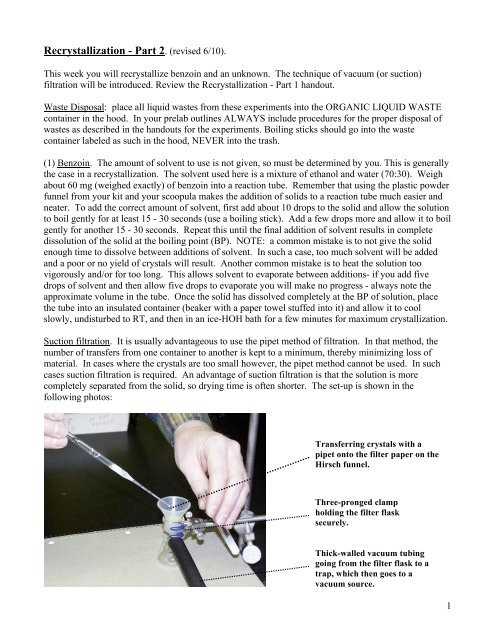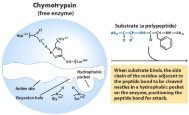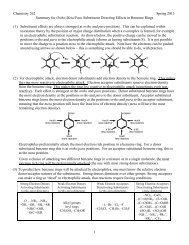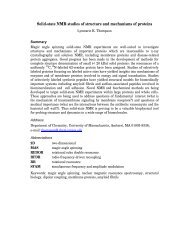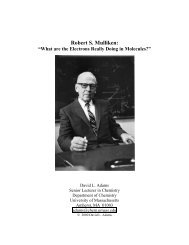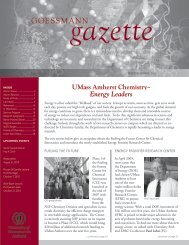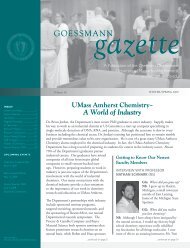Recrystallization - Part 2.
Recrystallization - Part 2.
Recrystallization - Part 2.
You also want an ePaper? Increase the reach of your titles
YUMPU automatically turns print PDFs into web optimized ePapers that Google loves.
<strong>Recrystallization</strong> - <strong>Part</strong> <strong>2.</strong> (revised 6/10).<br />
This week you will recrystallize benzoin and an unknown. The technique of vacuum (or suction)<br />
filtration will be introduced. Review the <strong>Recrystallization</strong> - <strong>Part</strong> 1 handout.<br />
Waste Disposal: place all liquid wastes from these experiments into the ORGANIC LIQUID WASTE<br />
container in the hood. In your prelab outlines ALWAYS include procedures for the proper disposal of<br />
wastes as described in the handouts for the experiments. Boiling sticks should go into the waste<br />
container labeled as such in the hood, NEVER into the trash.<br />
(1) Benzoin. The amount of solvent to use is not given, so must be determined by you. This is generally<br />
the case in a recrystallization. The solvent used here is a mixture of ethanol and water (70:30). Weigh<br />
about 60 mg (weighed exactly) of benzoin into a reaction tube. Remember that using the plastic powder<br />
funnel from your kit and your scoopula makes the addition of solids to a reaction tube much easier and<br />
neater. To add the correct amount of solvent, first add about 10 drops to the solid and allow the solution<br />
to boil gently for at least 15 - 30 seconds (use a boiling stick). Add a few drops more and allow it to boil<br />
gently for another 15 - 30 seconds. Repeat this until the final addition of solvent results in complete<br />
dissolution of the solid at the boiling point (BP). NOTE: a common mistake is to not give the solid<br />
enough time to dissolve between additions of solvent. In such a case, too much solvent will be added<br />
and a poor or no yield of crystals will result. Another common mistake is to heat the solution too<br />
vigorously and/or for too long. This allows solvent to evaporate between additions- if you add five<br />
drops of solvent and then allow five drops to evaporate you will make no progress - always note the<br />
approximate volume in the tube. Once the solid has dissolved completely at the BP of solution, place<br />
the tube into an insulated container (beaker with a paper towel stuffed into it) and allow it to cool<br />
slowly, undisturbed to RT, and then in an ice-HOH bath for a few minutes for maximum crystallization.<br />
Suction filtration. It is usually advantageous to use the pipet method of filtration. In that method, the<br />
number of transfers from one container to another is kept to a minimum, thereby minimizing loss of<br />
material. In cases where the crystals are too small however, the pipet method cannot be used. In such<br />
cases suction filtration is required. An advantage of suction filtration is that the solution is more<br />
completely separated from the solid, so drying time is often shorter. The set-up is shown in the<br />
following photos:<br />
Transferring crystals with a<br />
pipet onto the filter paper on the<br />
Hirsch funnel.<br />
Three-pronged clamp<br />
holding the filter flask<br />
securely.<br />
Thick-walled vacuum tubing<br />
going from the filter flask to a<br />
trap, which then goes to a<br />
vacuum source.<br />
1
The procedure for doing a suction filtration is described below. Using a small three-pronged clamp,<br />
clamp the 25 mL filter flask securely to a ring stand and place the plastic Hirsch funnel into it. The<br />
funnel should have a small, white polyethylene disk pressed into it. (If the disk is contaminated rinse<br />
water then acetone through the funnel. If that does not clean the disk, remove it and insert another. This<br />
should be done only in cases of obvious contamination - certainly no more than once per semester.) A<br />
small piece of filter paper is added to the top of the disk - it should lie flat on top of the disk. With<br />
vacuum (thick-walled) tubing connect the sidearm of the flask to the vacuum trap that is in place at your<br />
workspace. The trap (a large filter flask) is connected to the vacuum source in the fume hood. So that<br />
the filter paper sits properly in the funnel, it is good practice to add a few drops of fresh solvent to the<br />
filter paper just before pouring the crystals onto the filter paper as described next. With the vacuum<br />
turned on to full (a few turns of the valve), remove the reaction tube from the ice bath, wipe the water<br />
off of the outside of the tube with a paper towel, stir the crystals to loosen them and suspend them in the<br />
solution, and in one concerted movement, pour the solution and crystals onto the top of the Hirsch<br />
funnel (as shown in the photo, the crystals may also be transferred with a pipet). The vacuum will<br />
quickly pull the solvent down into the filter flask, leaving the crystals in the funnel. Sometimes it is<br />
necessary to push down gently on the funnel to create a seal. Using the spatula, scrape as many<br />
remaining crystals as possible from the tube onto the funnel. As always in a recrystallization, the<br />
crystals must be rinsed with fresh solvent (same as that used in the recrystallization) to remove<br />
impurities that cling to the surface of the crystals. To minimize redissolving and thus losing product, the<br />
rinse solvent must be ice cold, a minimum amount must be used, and it must be left in contact with the<br />
crystals for as short a time as possible. Break (interrupt) the vacuum briefly by lifting the Hirsch funnel<br />
up away from the filter flask slightly, and using about 10 drops of ice cold ethanol-water mixture, rinse<br />
out any crystals remaining in the reaction tube onto the Hirsch funnel, while at the same time covering<br />
the crystals in the funnel with rinse solvent. Immediately reestablish the vacuum by pressing the funnel<br />
back down onto the filter flask to remove the rinse solvent. If the vacuum is not broken first, the rinse<br />
solvent will quickly pass right down into the filter flask without rinsing off all the crystals. This<br />
technique is tricky and requires practice. It is important to go through the motions in a concerted<br />
fashion, without too much hesitation. It is well worth your while to do a dry run and go through the<br />
procedure before doing the actual filtration and rinse. At all steps along the way, try to keep the<br />
solutions cold by keeping the tubes immersed in the ice-water bath as much as possible. Using too<br />
much rinse solvent and allowing solvent to warm up before separating it from the crystals will result in<br />
the product redissolving and thereby being lost. It is also important to dry water from the ice bath off of<br />
the outside of the tubes so that the water does not dribble down onto the crystals.<br />
Because water is one of the solvents in this recrystallization, the crystals will need to dry at least<br />
overnight. When the crystals have dried to constant weight, weigh them and determine the % recovery.<br />
After the crystals are completely dry (left open to the air overnight) store them in a capped labeled vial.<br />
Before you dispose of the sample, have your instructor examine it (this is true for all samples). (Note<br />
that normally, whenever you obtain crystals such as these, you would determine the MP to assess the<br />
purity and to obtain a physical property, but for benzoin, to save time you will not take its MP.)<br />
Use of the vacuum outlet. Centralized vacuum pumps provide house vacuum in this lab. To prevent<br />
solutions from being sucked up into the vacuum outlet, always use a trap between your sample and the<br />
vacuum outlet. A trap, which is made from a 500 mL filter flask connected to the vacuum outlet with a<br />
piece of vacuum tubing, is available at each work space. To use the trap, simply attach a second piece<br />
of vacuum tubing to the filter flask side arm and connect this to the vacuum filtration set-up for filtering.<br />
Be sure to clamp the tube or filter flask securely so that it does not fall over. With the trap between the<br />
vacuum outlet and your product, if solution gets sucked up into the tubing, it will be trapped in the filter<br />
2
flask. In using the vacuum, turn the valve fully open and check to see that the vacuum is working by<br />
placing a finger on the vacuum connection.<br />
(<strong>2.</strong>) Purification of an Unknown. You will recrystallize two 60 mg samples of an unknown, using two<br />
different solvents. Your TA will assign the unknown to you. You must first determine at least two<br />
suitable recrystallization solvents by doing solubility tests (as in Recryst-1, it is not necessary to weigh<br />
solubility samples) and preparing a table. Several solvents are available to you in this experiment.<br />
These are water, methanol, ethanol, hexanes, and toluene. Try several of these solvents until you find at<br />
least two that work well. In some cases more than two solvents may show potential. Look for solvents<br />
that produce the highest recovery and the most well-formed crystals. After you decide upon the two<br />
solvents, weigh about 60 mg of unknown into a reaction tube. It does not have to be exactly 60 mg but<br />
it must be weighed exactly so that a % recovery can be calculated. Recrystallize the unknown from the<br />
first solvent of your choice. Note that water is a good solvent because it is non-toxic and non-flammable<br />
but that it does not evaporate readily. A sample recrystallized from water must be allowed to dry at least<br />
overnight. The solid will be filtered either by the pipet method or by suction filtration. If it seems that<br />
the crystals are large enough, try the pipet method. If crystals are sucked up into the pipet, you will need<br />
to do a suction filtration instead. Recrystallize a second sample of the same unknown using the other<br />
solvent. Once the recrystallized samples have dried to constant weight, weigh them and determine the<br />
MP. (CAUTION: always turn off the Mel-Temp and the digital thermometer after use (turn the voltage<br />
to zero AND turn the switches to off). If the Mel-Temp is left on, the apparatus may become overheated<br />
and damaged.) Using the MP, identify your unknown by checking the list of possible compounds shown<br />
below. Note that if the crystals are not completely dry, the solvent which remains will behave as an<br />
impurity and cause a MP depression. It may be useful to confirm your identification by considering<br />
other physical properties such as solubility behavior and color. Physical properties of many compounds<br />
are given in the Table of Physical Constants of Organic Compounds found in the "CRC Handbook of<br />
Chemistry and Physics", which is in the reference section of the Physical Sciences Library (a copy is<br />
also available in the lab). Chemfinder.com or a web search may be helpful as well. As part of the report,<br />
draw the structure of your unknown and comment on its structural features and how they might affect<br />
solubility.<br />
Report the yield, % recovery, and MP for each purified sample and the MP of the impure unknown for<br />
comparison. Even though you may need to allow samples to dry, to save time later on you can<br />
determine the MP of the impure compound during this lab period.<br />
Waste: dispose of recrystallization filtrates in the ORGANIC LIQUID WASTE container in the hood.<br />
When finished with the benzoin and unknown, place them into the Solid Waste container in the hood.<br />
Note: slow cooling of a saturated solution, without disturbance, usually produces larger, purer crystals.<br />
Removing solvent from larger crystals is easier than removing it from smaller crystals. Allowing the<br />
reaction tube to cool slowly in an insulated container is therefore advantageous. A crude insulated<br />
container can be fashioned by stuffing a piece of paper towel into a small beaker. The reaction tube can<br />
then be pushed into the wad of paper and allowed to cool slowly, without disturbance. Once the tube<br />
has cooled to RT, it may be further cooled in an ice-water bath to promote further crystallization.<br />
CAUTION: many organic compounds, especially nonpolar ones, sublime easily. This is how mothballs<br />
work. If left in the open for too long, such compounds will evaporate! Do not leave your unknown<br />
drying in the open for more than a few days. Once it is dry, place it into a capped vial until the next lab<br />
period.<br />
3
SAFETY: always assume that all lab chemicals are toxic and that they may be able to pass directly<br />
through your skin. Never handle lab chemicals with bare hands.<br />
BEFORE YOU LEAVE THE LAB: turn off the sand bath, Mel-Temp, air valve if used, and<br />
vacuum valve, put away your equipment and lock your drawer, clean up your work areas, close<br />
the fume hood sash completely, and ask your TA for her or his signature. In general, please try to<br />
keep the lab in as good condition as you found it. If you see caps off of bottles, replace the caps. If<br />
you see spilled chemicals, clean them up or at least report it to your TA.<br />
Being environmentally responsible. Cleaning reaction tubes: dispose of the contents of the tube in the<br />
correct waste container and wash the tube using soap, water, and a brush. If the tube must be used<br />
immediately, and if it must be free of water, rinse it with a SMALL amount of acetone (several drops a<br />
few separate times), drain the acetone into the Nonhalogenated Liquid Waste container in the hood, and<br />
turn the tube upside down to drip dry. If the glassware must be dried quickly, use the compressed air in<br />
the hoods. (Do not change the air flow without the help of your TA. Do not use the compressed air at<br />
your bench. Water and oil droplets in the air will contaminate the tube.) DO NOT FILL the tubes with<br />
acetone - this is wasteful and unnecessary- use just a little to rinse the tube. ALWAYS TRY TO<br />
MINIMIZE YOUR CHEMICAL WASTES - THIS INCLUDES WASH SOLVENTS.<br />
Postlab Questions<br />
1.) What solubility behavior is desired in a recrystallization solvent?<br />
<strong>2.</strong>) What would be the effect of using too much rinse solvent in a recrystallization?<br />
3.) In a recrystallization, what would be the effect of using rinse solvent that has not been cooled in ice?<br />
4.) How can you be certain that a sample is completely dry?<br />
5.) In a previous handout it was stated that "structure determines properties". Draw the structure of<br />
your unknown and comment on two characteristics that define its overall structure as described in the<br />
handout.<br />
6.) Based on what was discussed in the Structure-Property handout, list one specific example of each of<br />
the following general types of properties - chemical, physical, biological.<br />
7.) If your unknown is either compound A or B, both of which look the same and have similar physical<br />
properties, and you had samples of pure A and pure B, how might you unequivocally determine the<br />
identity of your unknown, using MPs (hint: see the MP handout)?<br />
4
Possible Unknowns:<br />
Compound MP (°C)<br />
1,1-diphenylacetone 61<br />
benzhydrol 69<br />
phenylacetic acid 77<br />
α-methyladipic acid 85<br />
benzil 95-96<br />
o-toluic acid 105<br />
acetanilide 115-116<br />
trans-stilbene 124-125<br />
benzoin 133-134<br />
2-chlorobenzoic acid 142<br />
adipic acid 152<br />
salicylic acid 159<br />
3,5-dimethylbenzoic acid 166<br />
Values here may differ slightly from those<br />
on the Melting Point list because you have<br />
purified the compounds. Melting point<br />
values here are from the CRC Handbook,<br />
54 th edition.<br />
5


